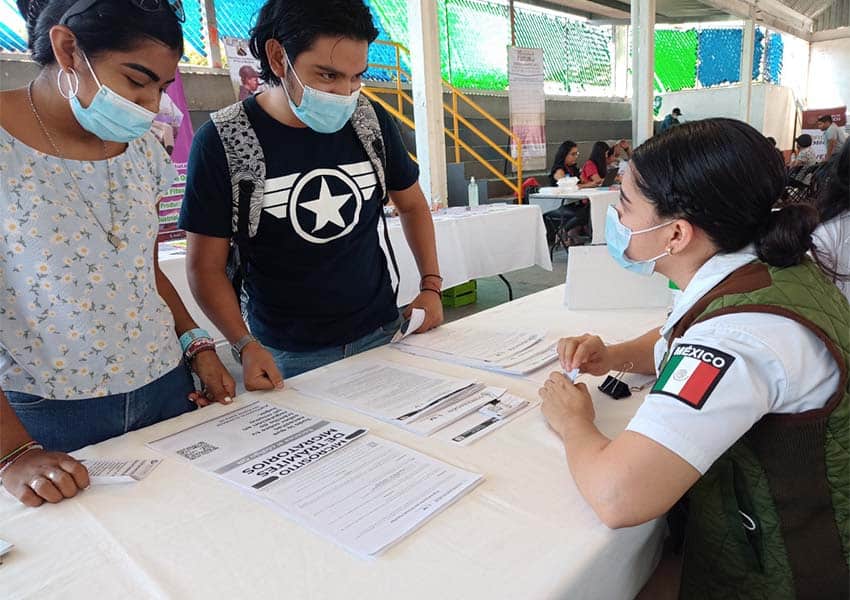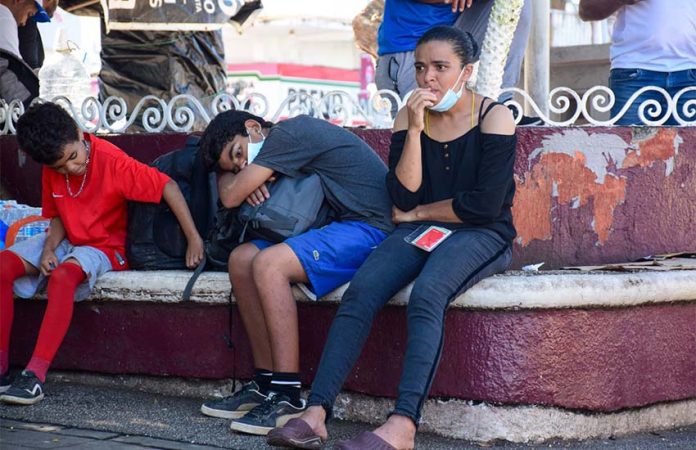In an effort to gain control of migration over Mexico’s southern border, President López Obrador has met with the governors of Oaxaca, Chiapas and Veracruz .
Governors Alejandro Murat, Rutilio Escandón and Cuitláhuac García visited the National Palace on Thursday, where they discussed coordination between state and federal authorities to advance plans for migration and development on Mexico’s border with Guatemala and Belize.
“We emphasize the commitment of the Government of Chiapas to continue working with the Federal Government to address this social phenomenon,” Chiapas Governor Escandón said in a tweet.
Immigration and security authorities in southern Mexico have stepped up border enforcement operations in recent weeks after months of the federal government seeming to tacitly encourage migrants to leave the border town of Tapachula, most likely to relieve pressures in the area due to a backlog of migrants waiting to process applications with Mexico.

Now migrants are reporting to multiple media sources more activist measures to block their passage north. Highway patrols, checkpoints and raids have all increased, and a number of small migrant caravans have been broken up.
“[For] two consecutive days, the Guard and immigration have come to run off the people because a caravan was supposedly going to form,” one Honduran migrant in Tapachula told the Associated Press (AP) on Wednesday.
There have even been violent clashes between migrants and officials from the National Migration Institute (INM). Last week, a group of migrants attacked an INM vehicle transporting foreigners in Pijijiapan, Chiapas, and a riot broke out in early November among migrants demanding release from the Siglo 21 detention center in Tapachula.
Meanwhile, an estimated 12,000 to 17,000 migrants remain waiting for temporary documents at the immigration center in San Pedro Tapanatepec, Oaxaca, according to the United States-based Migrant Rights and Justice Program at the Women’s Refugee Commission. The organization’s Senior Policy Advisor Savi Arvey told AP that there are lengthening waits at the facility, with migrants sleeping on the streets or on rented floor space in town. She also said that the INM has no presence at the camp and that nongovernmental organizations do not have access to the government tents.
It’s the third time in as many months that AMLO has convened meetings with governors about migration policy. On Sept. 27, Oaxaca Governor Alejandro Murat tweeted about a similar meeting he attended with the same three governors at the National Palace.El día de hoy, acudí a Palacio Nacional, nos reunimos con el Presidente @lopezobrador_ y parte de su gabinete, así como, con gobernadores del Sur – Sureste revisamos la agenda migratoria. Seguimos trabajando por #Oaxaca. #Migración pic.twitter.com/ZOY8iUTYRa
— Alejandro Murat (@alejandromurat) September 27, 2022
“There needs to be a much greater humanitarian presence, especially given how long this has persisted,” she said. “It seems like people are spending longer and longer there.”
“The camp is the worst thing ever, because there’s sickness and there’s filth,” said José María López, a Venezuelan migrant who is currently in the camp for a second time, told Reuters. “It’s uninhabitable.”
Although Mexican authorities have not stated the reason for the tightened border enforcement, it appears to follow a policy shift in October in which the U.S. is now expelling Venezuelan migrants to Mexico under Title 42 public health regulations. Expulsions were already allowed for Guatemalan, Honduran and Salvadoran nationals, as well as Mexicans — the latter having the highest percentage of Title 42 expulsions in FY 2022 by country of origin, according to the Migration Policy Institute.
A further shake-up came on Tuesday, when a U.S. federal judge blocked all Title 42 expulsions, although the U.S. government was given a five-week stay of the court order to prepare for the change. In the wake of the ruling, municipal authorities in San Pedro Tapanatepec threatened to organize mass caravans out of the camp unless the federal government dismantles it soon.
Migration over Mexico’s southern border has been increasing for some time, partly driven by the coronavirus pandemic and deteriorating conditions in countries like Venezuela, Cuba and Nicaragua. Asylum applications increased a hundredfold between 2013 and 2021, according to the Washington Office on Latin America (WOLA).
With reports from Associated Press, Reuters, Excelsior and Latin US
